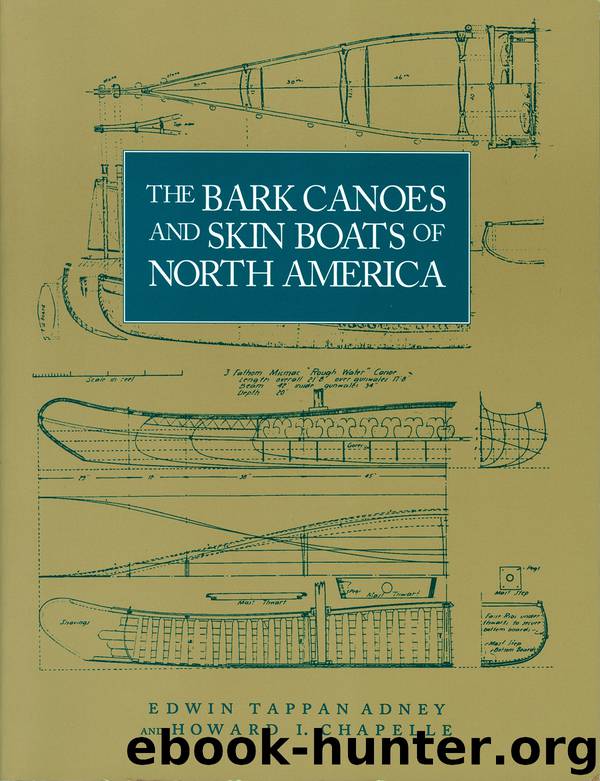The Bark Canoes and Skin Boats of North America by Edwin Tappan Adney

Author:Edwin Tappan Adney [Adney, Edwin Tappan]
Language: eng
Format: epub
ISBN: 978-1-58834-522-6
Publisher: Smithsonian
Published: 2015-10-27T04:00:00+00:00
Algonkin
The Algonkins were a tribe residing on the Ottawa River and its tributaries, in what are now the provinces of Quebec and Ontario, when the French first met them. They appear to have been a large and powerful tribe and were apparently competent builders and users of birch-bark canoes. They were not the same tribe as the Ottawa, who controlled the Lake Huron end of the canoe route between Montreal and Lake Superior, by way of the Ottawa River. These Ottawa were related to the Ojibway tribe and received their name from the French, who gave the name Outaouais, or “Ottaway,” to all Indians, except the Hurons, who came from the west by way of the Ottawa. The Algonkins, because of their location, were much influenced by the French fur trade. Early in the 18th century they intermingled with certain Iroquois whom they allowed to settle with them, near Montreal, at the Lake of Two Mountains, later Oka. Thence they gradually spread out and lost tribal unity, until only small groups were left. These lived on the Golden Lake Algonkin Reserve, Bonshere River, Ontario; at Oka, Quebec; and elsewhere in western Quebec and eastern Ontario. It is possible that they were the first to build fur-trade canoes for the French, but evidence to support such a claim with any certainty is lacking.
Due to intermixing with other tribal groups and to the influence of the fur trade, in which they were long employed as canoe men and builders, the Algonkins no longer used a single tribal model of canoe. However, one of their models, which had high ends resembling those of the large fur-trade canoe, may have been the tribal type from which the fur-trade canoe was developed, as will be seen.
The high-ended model, the oldest form known to have been used by this tribe, was narrow-bottomed, with flaring sides. The canoes seen were built with careful workmanship and in the old manner, without iron fastenings. They were light and easily paddled, yet would carry a heavy load. The ends were sharp at the line of flotation. The bottom was straight to a point near the ends, where it lifted somewhat. The sheer was rather straight over the middle portion of the canoe, then lifted slightly until close to the stem, where it rose sharply, becoming almost perpendicular at the ends of the rail caps. The midsection was slightly rounded across the bottom, with a well-rounded bilge and a gently flaring topside. The cross-section became V-shaped close to the headboards. The most marked feature in the appearance of this canoe was the profile of the ends. The stem line, beginning with a slight angle where it joined the bottom, bent outward in a gentle curve, reaching the perpendicular at a point a little more than half the height of the end, and from there it tumbled home slightly. In most of the canoes examined the top of the stem then rounded inboard in a quick, hard curve, usually almost half a circle, so that the stem was turned downward as it joined the outwale and gunwale cap.
Download
This site does not store any files on its server. We only index and link to content provided by other sites. Please contact the content providers to delete copyright contents if any and email us, we'll remove relevant links or contents immediately.
Breath by James Nestor;(2162)
The River by Peter Heller(2152)
Deep by James Nestor(2087)
Fatal Storm by Rob Mundle(2084)
Sea Survival Handbook by Keith Colwell(2044)
Lonely Planet Australia by Lonely Planet(1974)
Iced In by Chris Turney(1853)
Discover Australia by Lonely Planet(1845)
Lonely Planet Maldives (Travel Guide) by Planet Lonely & Masters Tom(1736)
One Girl One Dream by Dekker Laura(1581)
Looking for a Ship by John McPhee(1577)
Ten Degrees of Reckoning: The True Story of a Family's Love and the Will to Survive by Hester Rumberg(1554)
Chicken Soup for the Ocean Lover's Soul by Jack Canfield(1552)
Lonely Planet Australia (Travel Guide) by Lonely Planet & Lonely Planet(1512)
South with the Sun by Lynne Cox(1463)
The Wave In Pursuit of the Rogues, Freaks and Giants of the Ocean(1431)
Diver Down by Michael Ange(1422)
Marlinspike Sailor's Arts and Crafts by Barbara Merry(1412)
The Golden Rules: 10 Steps to World-Class Excellence in Your Life and Work by Bob Bowman & Charles Butler(1385)
